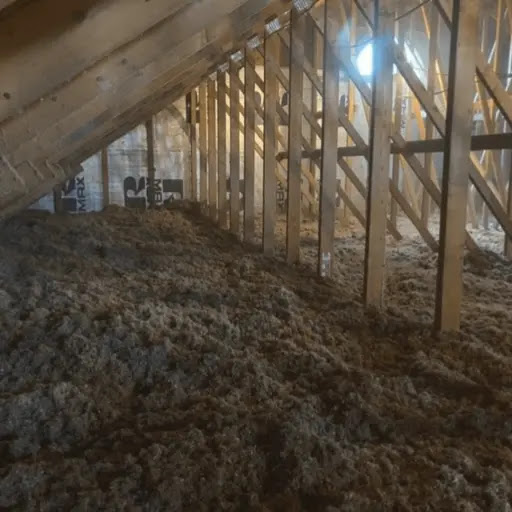How Dense-Pack Cellulose Maximizes Home Energy Efficiency
Dense-pack cellulose insulation dramatically improves home energy efficiency by establishing a robust thermal barrier and an airtight seal within walls, attics, ceilings, and floors. This innovative method densely compacts cellulose fibers, drastically reducing airflow, minimizing conductive and convective heat transfer, and consequently lowering overall energy consumption. Homeowners who prioritize superior insulation performance often turn to dense-pack cellulose for its verified capacity to slash heating and cooling expenses, bolster indoor comfort year-round, and support sustainable building practices.
This guide delivers an in-depth exploration of dense-pack cellulose insulation, including its working principles, comparative advantages, essential technical data, and crucial pre-installation considerations. By the end, you will have a comprehensive understanding to make an informed decision.
How Dense-Pack Cellulose Works
Dense-pack cellulose insulation utilizes finely shredded recycled paper treated with fire retardants. This material is pneumatically blown into wall cavities and building assemblies at high densities, typically ranging from 3.5 to 4.0 pounds per cubic foot. The densely packed fibers form an intricate network that effectively obstructs air pathways, a major culprit behind energy loss in conventional insulation systems.
Key mechanisms include:
High-Density Compaction: Restricts air movement to nearly zero, reducing drafts and heat escape.
Consistent R-Value Retention: Maintains thermal performance even as environmental conditions fluctuate.
Sound Dampening Properties: Creates quieter indoor environments by absorbing airborne sounds.
Environmentally Responsible Materials: Sourced predominantly from post-consumer recycled paper.
Dense-pack cellulose outperforms many traditional materials by addressing both thermal and air barrier needs simultaneously, a crucial factor often overlooked in standard insulation upgrades.
Technical Specifications of Dense-Pack Cellulose
Benefits of Dense-Pack Cellulose for Energy Efficiency
Dense-pack cellulose delivers multiple advantages that go beyond conventional insulation approaches:
Superior Air Sealing: Minimizes convective heat loss, enhancing HVAC system efficiency.
Enhanced Thermal Performance: Consistent and reliable R-value even under temperature variations.
Environmental Stewardship: Utilizes up to 85% recycled material, reducing landfill waste.
Extended Lifespan: Densely packed fibers resist settling and degradation over time.
Fire Protection: Built-in fire retardants slow flame spread.
Moisture Management: Works synergistically with vapor retarders to minimize mold risks.
Bonus Tip
In retrofits where full wall exposure isn't feasible, dense-pack cellulose offers an excellent minimally invasive solution without requiring extensive demolition.
Comparison of Insulation Methods
Bonus Tip
For homes aiming for net-zero energy standards, dense-pack cellulose combined with exterior rigid insulation panels offers an optimal high-performance envelope.
Things to Consider Before Making a Decision
Before choosing dense-pack cellulose, careful planning is essential to maximize its benefits:
Wall Cavity Suitability: Ensure existing wall assemblies can accommodate the necessary density without risking structural stress.
Climate and Regional Factors: In regions with high humidity or extreme cold, integrating smart vapor retarders enhances moisture management.
Cost Analysis: While denser installation involves higher upfront costs compared to fiberglass, the long-term energy savings often outweigh initial expenditures.
Professional Installation Needs: Dense-pack requires specialized equipment and experienced installers to achieve optimal density and air seal effectiveness.
Building Codes and Standards: Verify local code requirements regarding fire ratings, vapor control layers, and insulation materials.
Pest Deterrence: Although treated, installing additional pest barriers in vulnerable areas can further enhance durability.
Bonus Tip
Always insist on a pre- and post-installation blower-door test to quantify air leakage reductions and validate installation quality.
Common Questions About Dense-Pack Cellulose
Does dense-pack cellulose settle over time?
Properly installed dense-pack cellulose experiences less than 2% settling, preserving thermal performance without requiring topping up.
Is dense-pack cellulose safe for indoor air quality?
Yes. Treated with borate-based fire retardants, dense-pack cellulose is non-toxic and contributes to healthier indoor air.
Can dense-pack cellulose be installed in existing walls?
Absolutely. Technicians drill small access holes, blow in the material, and patch the holes, making it ideal for retrofitting without extensive wall demolition.
How long does dense-pack cellulose insulation last?
With correct installation and proper moisture management, dense-pack cellulose can reliably last 30 years or longer.
Is dense-pack cellulose resistant to mold?
While cellulose is treated for mold resistance, maintaining proper vapor management and drainage systems is key to preventing moisture-related issues.
Does dense-pack cellulose help with noise control?
Yes. Its dense structure significantly reduces noise transmission compared to traditional fiberglass batt insulation.
Dense-Pack Cellulose Maximizes Home Energy Efficiency FAQ
What R-value does dense-pack cellulose achieve?
Dense-pack cellulose provides an R-value between R-3.6 and R-3.8 per inch, making it highly competitive with many insulation alternatives.
Is dense-pack cellulose more eco-friendly than spray foam?
Yes. Cellulose relies on post-consumer recycled materials and requires less energy for manufacturing compared to petrochemical-based spray foams.
Does cellulose provide better soundproofing than fiberglass?
Yes. Dense-pack cellulose has a Sound Transmission Class (STC) rating significantly higher than fiberglass batts, resulting in quieter interiors.
Can I install dense-pack cellulose myself?
It is not advisable. Proper installation requires professional-grade equipment and training to achieve necessary compaction and coverage.
Does dense-pack cellulose need a vapor barrier?
Depending on climate, a vapor barrier or smart vapor retarder may be necessary to control moisture migration through walls.
Make the Right Decision
Dense-pack cellulose insulation services offer a compelling balance of superior thermal performance, excellent air sealing, high recycled content, and sound dampening benefits. It stands out as a responsible and cost-effective solution for homeowners seeking to lower energy costs, increase comfort, and promote sustainable living practices. Assess your home's structure, regional climate, energy goals, and budget to determine whether dense-pack cellulose is the right fit. When installed by qualified professionals, it delivers long-lasting, measurable improvements in home energy efficiency and indoor living quality.




Comments
Post a Comment